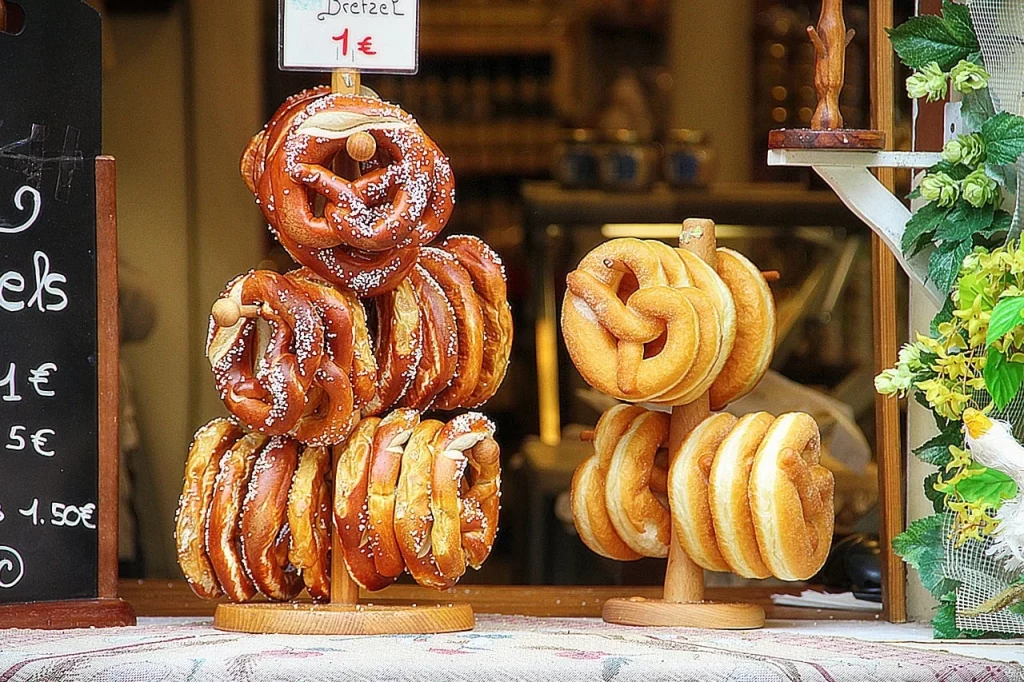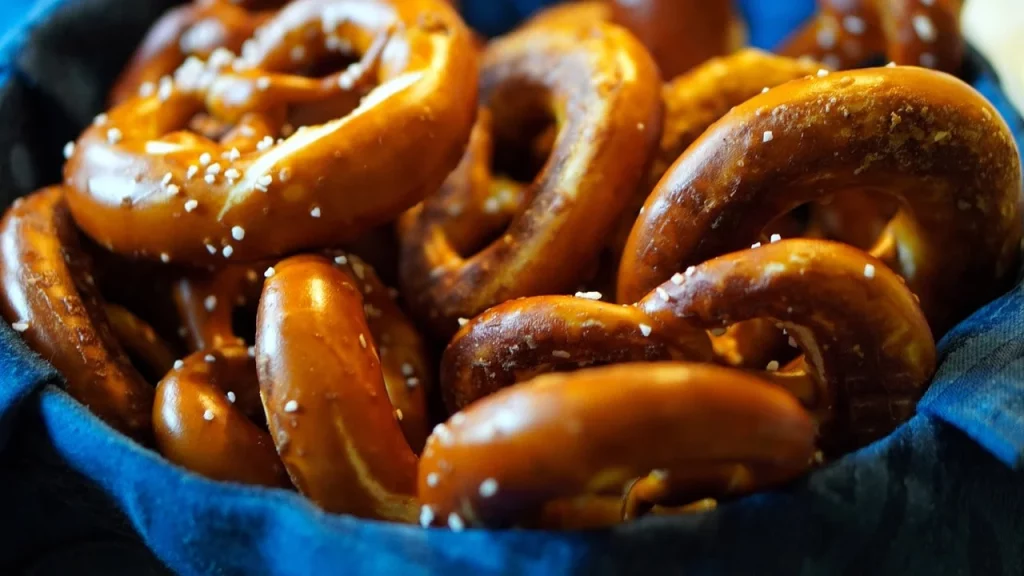Welcome to the twisted world of pretzels, where the only thing more tangled than the dough is the history behind it. Those salty, crunchy snacks that have infiltrated every movie theater, party, and heart in America have a backstory as knotty as their shape.
Did you know that they have been bending the rules of baking since the Middle Ages? Yes, you heard it right. While most snacks crumble under pressure, pretzels twist and shout their way through history, flaunting their iconic loops like a fashion statement.
But how did a simple mixture of water, flour, and salt become the superstar of snacks? Are pretzels really the secret behind locking in that movie theater aroma? Let’s unravel the mystery together.
Life is like a pretzel: twisted, salty, and surprisingly satisfying when you embrace its curves.
Chef Wolfgang Puck
Pretzel Facts
Before diving into the world of pretzels, remember to pay close attention to the salty, savory facts ahead. There’s a quiz at the article’s end to test your expertise on this beloved snack.
- The creation of these snacks can be traced to 610 A.D., attributed to European monks as rewards for children who memorized their prayers.
- Historically, they’ve been seen as symbols of fortune and wholeness of the soul.
- Its iconic twist is said to mimic the posture of prayerful hands.
- In the 1500s, they were integral to wedding rituals, symbolizing the bond of matrimony.
- The term “tying the knot” is believed to have sprung from their shape.
- Pennsylvania Dutch settlers were pivotal in making them a staple in the U.S.
- National Pretzel Day is observed on April 26 in the United States.
- The United States’ first pretzel factory was established in 1861 in Lititz, Pennsylvania.
- Since the 1800s, they’ve been a familiar sight in New York City through street vendors.
- The heaviest one ever crafted weighed 842 pounds and measured over 26 feet in length.
- They are available in crunchy and soft varieties, differing in texture and taste.
- The unique brown and glossy finish is achieved through an alkaline solution bath.
- Germany boasts a deep-rooted history as the global epicenter for pretzel lovers.

- Weidenberg, Germany, is renowned for baking the longest one on record.
- In southern Germany, bakers once used them as an insignia for their guilds.
- Philadelphia is home to a museum entirely devoted to the heritage of pretzels.
- It’s estimated that every American eats about 1.5 pounds of pretzels annually.
- The 20th century saw mechanization make their production more efficient and affordable.
- Flavors have expanded to include innovative combinations like peanut butter and jalapeño.
- Because of their basic ingredients, they were a common Lenten food.
- Gluten-free options are now available, accommodating those with specific dietary needs.
- Freeport, Illinois, stakes its claim as the pretzel capital within the U.S.
- Gourmet varieties now feature exquisite flavors like white and black truffle.
- Aside from the classic shapes, they can be found as sticks, nuggets, and loops.
- Dipped in chocolate, they become a favored snack during the holidays.
- During Oktoberfest in Germany, pairing them with beer is a popular tradition.
- A classic pretzel has three holes, symbolizing the Christian concept of the Trinity.
- While hard pretzels can last for months, soft ones are best eaten fresh.

- Mustard or cheese dips are common accompaniments for the soft variety.
- Breaking one on New Year’s is seen as a gesture for good luck in some traditions.
- The skill of creating the perfect twist is traditionally executed in a single, fluid motion.
- 1935 saw the debut of the world’s first pretzel-making machine.
- In Bavaria, a sweet mustard often accompanies them.
- Professional bakers use special cutters to achieve that iconic shape.
- Its sprinkled salt not only enhances flavor but also aids in creating the perfect crust.
- Consumption of soft pretzels is best when fresh, as they quickly become stale.
- They serve as a traditional side for soups and stews in various cultures.
- A “Bretzeli” is a traditional Swiss variant, thinner and crisper.

- Philadelphia’s unique version stands out for its distinct shape and flavor.
- They’ve been a prosperity symbol, featuring in many coats of arms.
- For deeper flavors, some artisanal producers let their dough ferment overnight.
- A “pretzel croissant” represents a modern, sweet take on the classic form.
- In the Middle Ages, they were thought to possess medicinal benefits.
- Interlocking loops in a pretzel are said to symbolize love and unity.
- They’ve been depicted in various artistic works, from paintings to sculptures.
- Handcrafting them is viewed as an artisan skill, especially valued in European traditions.
- Some interpretations suggest the three holes represent faith, hope, and charity.
- The “Pretzel Roll” variant is popularly used for making sandwiches.
- Legend holds that the pretzel’s looped design was a means for bakers to hang them on sticks, maximizing space in small ovens—a practice that subtly influenced street vendor displays in modern times.
- During the 17th century, pretzels were believed to ward off evil spirits and bring good fortune, especially when hung on Christmas trees as an ornament, blending culinary tradition with seasonal festivities.
Pretzel Myths

Transitioning from the facts, we now venture into the realm of myths. Let’s separate the wheat from the chaff and discover which stories hold a grain of truth.
- Pretzels Were Invented In Italy
Contrary to popular belief, they were not invented in Italy. It is widely accepted that pretzels have their origins in Europe, specifically in the monasteries of the Early Middle Ages, around the 7th century. Monks are credited with creating pretzels from dough as a reward for children who learn their prayers. The pretzel’s distinct shape is said to represent folded arms in prayer. - Pretzels Always Come Salted
While many people associate them with a salty flavor, they are not always made with salt. They can be found in a variety of flavors, including sweet versions coated in cinnamon sugar, chocolate, or glazes. The variety is vast, catering to different taste preferences around the world. - Pretzels Have No Nutritional Value
This belief is not entirely accurate. Pretzels made from whole grains can provide a decent source of dietary fiber, B vitamins, and minerals such as iron and magnesium. However, like all foods, they should be consumed in moderation as part of a balanced diet due to their potential high sodium and calorie content. - Hard Pretzels Were Intentionally Created
The creation of hard pretzels was actually a happy accident. It is believed that in the 17th century, a baker’s apprentice in Pennsylvania overbaked his pretzels, resulting in a crispy, crunchy texture. This mistake was well-received, leading to the popular snack enjoyed by many today. - Pretzels Are Only Popular In Germany
While it is true that they hold a special place in German culture, especially during Oktoberfest, their popularity extends far beyond Germany. They have been widely embraced in the United States, where they are considered a staple snack food, and their popularity is growing in other parts of the world as well.
No products found.
Pretzel FAQ

Before you dive into the quiz, make sure to check out our FAQ section to answer any lingering questions and solidify your pretzel expertise.
- Are pretzels healthy?
They can be a healthier snack option compared to many others, especially if they are whole grain and low in salt. However, like anything, moderation is key. Many store-bought pretzels are high in sodium and can be made with refined flour, so it’s wise to check the labels or consider making your own for a healthier twist. - Can pretzel dough sit overnight?
Yes, pretzel dough can sit overnight. In fact, letting it rest in the refrigerator can enhance the flavor through slow fermentation. Just make sure to cover it tightly to prevent it from drying out. When you’re ready to bake, let the dough come to room temperature and proceed with your recipe. - Who invented the pretzel?
The pretzel has a long history, and while its exact origins are a bit murky, it is believed to have been invented by European monks around the early Middle Ages, possibly in Italy or Germany. The twisted shape is said to represent arms crossed in prayer, making pretzels one of the world’s oldest snack foods. - Why do pretzels have a distinctive shape?
The classic twist of a pretzel is not just for looks; it has historical and cultural significance. The loops of the pretzel are thought to represent arms crossed in prayer, reflecting the item’s religious origins in European monasteries. This shape has been retained over centuries as the snack has evolved and spread worldwide. - Can pretzels be made gluten-free?
Yes, they can be made gluten-free by using alternative flours such as rice flour, cornstarch, or a gluten-free flour blend. The key is to find the right mix that will still give you a doughy texture and the classic pretzel taste. Gluten-free pretzels are also available in many stores for those who prefer to avoid baking.
Pretzel Trivia

Welcome to the ultimate pretzel quiz! Brace yourself, because if you don’t knot a single answer correctly, you’ll be sentenced to a year of unsalted, twist-less existence.
Conclusion
Pretzels carry a legacy steeped in tradition, innovation, and cultural significance that spans continents and centuries. From their supposed monastic origins to becoming stadium staples and gourmet treats, pretzels have proven their versatility and enduring appeal. They’ve been symbols of luck, a means of sustenance, and now a canvas for culinary creativity.
As we conclude our pretzel pilgrimage, let’s remember that these knotted treats are a testament to the simple joy of baking and the shared pleasures of eating. So, the next time you unwrap a pretzel, consider its journey from ancient ovens to your hands. Till next time, stay curious. Cheers.


